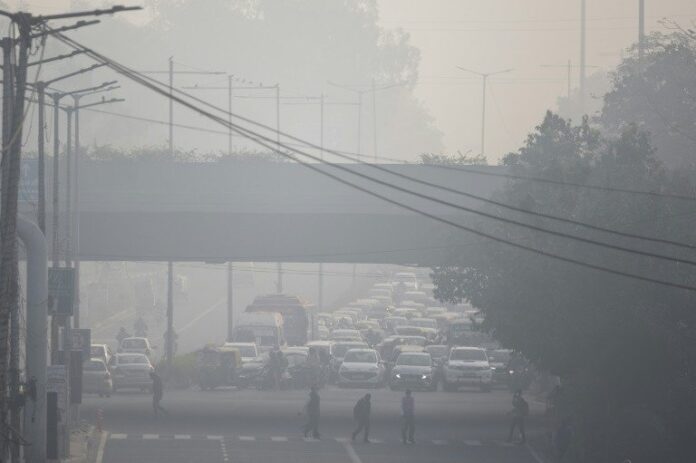NEW DELHI: After decades commuting on New Delhi’s parlous roads, office worker Ashok Kumar spends more time than ever stuck in the gridlock that packs the Indian capital’s thoroughfares and pollutes the city.
The sprawling megacity of 20 million people is regularly ranked the world’s most polluted capital, with traffic exhaust a main driver of the toxic smog that permeates the skies, especially in winter.
Delhi’s patchwork public transport network struggles to cater for a booming population, with long queues snaking outside the city’s underground metro stations each evening and overloaded buses inching their way down clogged arterials.
“When I came to Delhi, the air was clean because there were hardly any cars or bikes on the roads,” Kumar told AFP while waiting for a ride home outside the city’s main bus terminal.
“But now everyone owns a vehicle.”
Kumar spends nearly four hours each day in a “gruelling journey” to and from his home on Delhi’s far southern outskirts, alternating between commuter buses, private shared taxis and rickshaws.
Even at the age of 61, Kumar is hoping to save enough money to buy his own scooter and spare himself the pain of the daily commute.
“Not many people can afford to waste their time on public transport,” he said.
Private vehicle registrations have tripled in the last 15 years — there are now more than 13 million on the capital’s roads, government figures show.
The consequences are felt year-round, with Delhi road users spending 1.5 hours more in traffic than other major Asian cities, according to the Boston Consulting Group.
But come winter the daily inconvenience escalates into a full-blown public health crisis, as prevailing winds slow and the thick blanket of haze settles over the city sees a surge in hospital admissions from residents struggling to breathe.
Vehicle emissions accounted for more than half of the city air’s concentration of PM2.5 — the smallest airborne particles most hazardous to human health — at the start of November, Delhi’s Centre for Science and Environment (CSE) said.
A study from the centre last year showed the capital was experiencing a steady decline in public transit ridership.
Infrastructure has improved since the turn of the century, when Delhi inaugurated the first links in an underground rail network that now spans more than 250 stations and stretches into neighbouring satellite cities.
But the CSE said long distances between metro stops and residential areas was pushing commuters to switch to private vehicles.
“The Metro is convenient but I still had to take an auto-rickshaw or shared taxi from the station to my home,” Sudeep Mishra, 31, told AFP.
Mishra’s daily commute was a 50-kilometre (30-mile) return journey, including the two kilometres he had to navigate between the nearest station and his home — now all done on a second-hand motorbike.
“It was a hassle and expensive as well,” said Mishra, also a white-collar worker. “It made more sense to buy my vehicle to save time and money.”
Experts say this poor last mile connectivity is a particular issue for women, who often have to choose between private transport or risking a walk on dark and unsafe streets.
The move to private vehicles has seen Delhi’s bus network atrophy, with more than a hundred bus routes culled since 2009.
The state-run Delhi Transport Corporation’s fleet has shrunk by nearly half since a decade ago and last ordered new buses in 2008 — with a planned expansion marred by corruption claims.
There is a direct link between this underinvestment in public transport and the capital’s worsening air pollution, said Sunil Dahiya, a New Delhi-based analyst with the Centre for Research on Energy and Clean Air.
Official campaigns have attempted to lighten the haze in recent years, with the city at one point banning vehicles from the roads using an alternating odd-even system based on licence plate numbers.
Groups of youngsters are paid to stand at busy traffic intersections, waving placards urging drivers to turn off their ignitions while waiting at red lights.
And incentives have been offered for electric vehicle owners, but with only 145 charging stations across the city, take-up has been slow.
Dahiya told AFP that only a huge investment to make public transport more appealing and convenient would start to solve the intractable problem.
“We need aggressive growth in public transport to start seeing an absolute reduction in air pollution levels,” he said.























